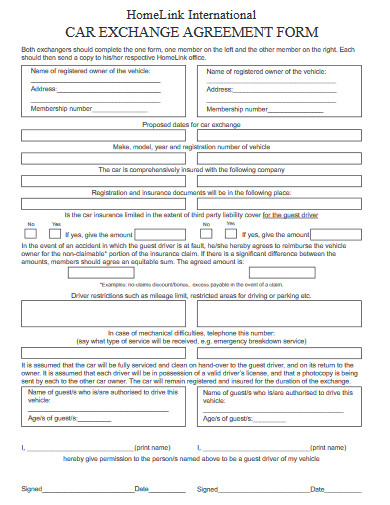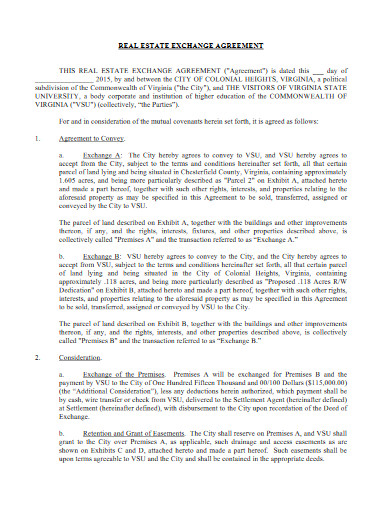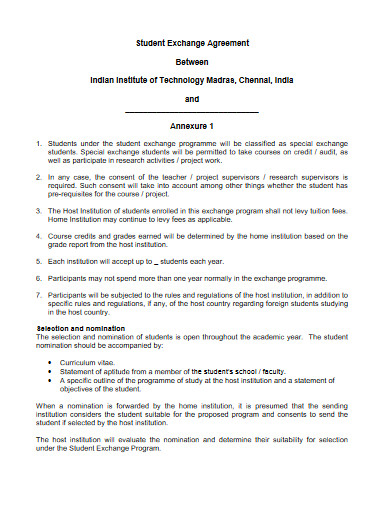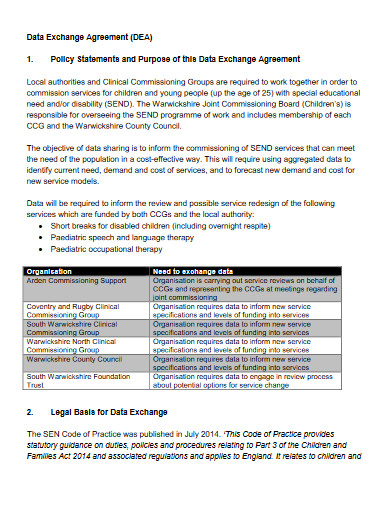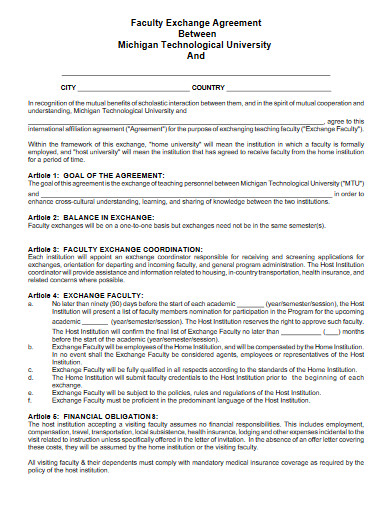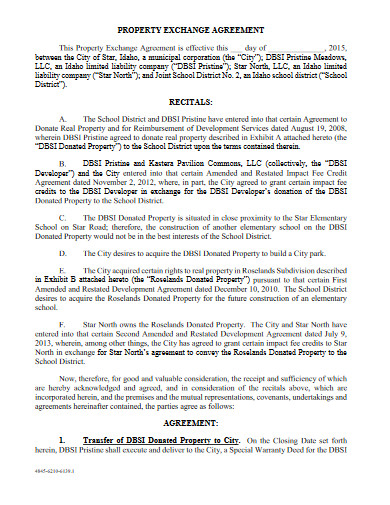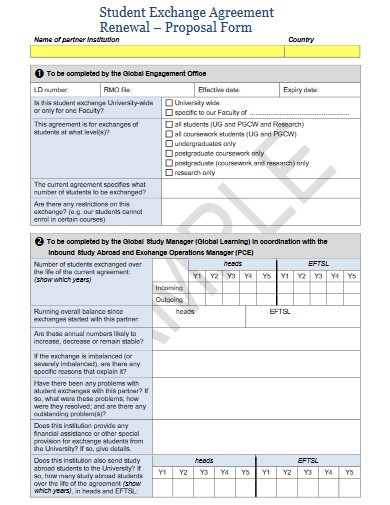10+ Exchange Agreement Examples to Download
Manufacturers and service providers get involved with exchanges now and then. It is already a part of their respective business to grant a fair trade, whether about product or property purchases or delivery of a certain service or even profit shares. The parties of these kinds of deals or settlements are not new to the risks that come with said transactions. And so, for every partnership or business affair they get into, they always produce a signed legal contract or agreement that elaborates the complete stipulations of the arrangement, such as the confidentiality of proprietary information. Speaking of the agreements, you better check our article on exchange agreement and some of its examples below.
10+ Exchange Agreement Examples
1. Asset Exchange Agreement Template
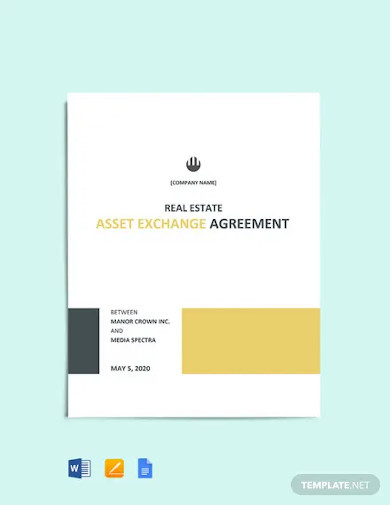
2. Confidential Information Exchange Agreement Template
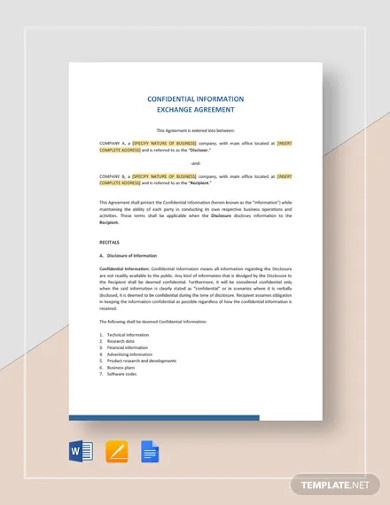
3. Exchange of Shares Agreement Template
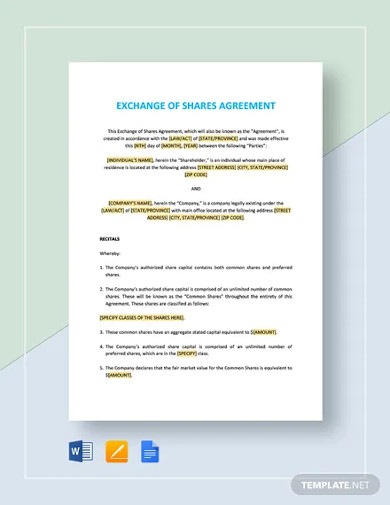
4. Car Exchange Agreement Form
5. Real Estate Exchange Agreement
6. Student Exchange Agreement
7. Data Exchange Agreement
8. Land Exchange Agreement
9. Faculty Exchange Agreement
10. Property Exchange Agreement
11. Student Exchange Agreement Form
What Is an Exchange Agreement?
An exchange agreement is a legal document that delineates the complete exchange arrangement between two parties. Usually, organizations create such an agreement to settle debts without involving any money, but rather through properties, shares, and others. However, these properties should have the same value as the debtor’s owed money. Sometimes, the document deal also highlights common trading transactions between a seller and a regular buyer. The main importance of this document is that it provides proof of transactions, as well as of the terms and conditions that come with it. Through its participants’ signatures, this kind of business requirements document is enforceable by law.
Different Types of Exchange Agreements
As mentioned above, an exchange agreement may regard the purchase of a particular product or property or to carry out services. In this section, you will learn as to where organizations use the document, specifically.
1. Land Exchange – An exchange of two parties that involves a land property. An excellent example of this is the trade-off of a government land property with some private land property.
2. Service Exchange – This type of exchange agreement pertains to one party’s offer of a specific service in exchange for a particular service from another party. For example, a law firm offers regular consultancy to an HVAC service provider in exchange for the latter’s routine maintenance.
3. Real Estate – In this exchange, one party offers to put their property on the line to pay a debt or to acquire another type of property.
4. Currency Exchange – For this exchange, two individual organizations agree to exchange monetary means with different currencies but with special considerations, like fluctuations and exchange rates.
How to Create an Exchange Agreement
Writing agreements follows the same workflow as writing contracts. This means that the technical writing practices that attorneys and technical writers adapt when making contracts also apply in creating an agreement. The most important aspect of such a composition process is knowing what the sections are following the standards. To help you with that, take heed of our standard-based outline below.
1. Provide Purpose and Summary
Always kick-off your document by providing the statement of purpose. To do this, give out the general description of an exchange agreement briefly and comprehensively, and associate parties’ mutual intentions. Moreover, provide a summary of your planned agreement. Point out its content sections and present each of its important points in a nutshell.
2. Name the Participants
Before you proceed to the next section, don’t forget to mention your organization and the other party’s basic information, such as the names and addresses. You must also include the date of the agreement takes effect. You can insert these pieces of information in the statement of purpose. Also, you have to indicate each participant’s role, specifying which party offers the deal and which party accepts the offer.
Example: This exchange agreement between Company A of 260 Phili Lane, Maysville, Oklahoma 72747, and Company B of 3084 Ottis Street, Yukon, Oklahoma 73099, presents the complete exchange of services effective on 21st of August 2020
3. Describe the Subjects for Exchange
After providing the purpose, summary, and the participant’s basic information, specify and describe the subjects for exchange. First, determine whether it is a product, property, or service. Then, include their types, prices, or rates thoroughly.
4. Enumerate the Terms and Conditions
Once you have successfully described the subjects for exchange, you can proceed in enumerating the terms and conditions. In this section, you have to provide full details on each party’s liabilities and duties to meet the program documentation’s requirements. This section may involve the payment schedule and method for unforeseen expenditures.
5. Protect the Proprietary Information
Keep your agreement between you and the other party only. To ensure that none of you discloses any vital and private information, you have to include a non-disclosure agreement (NDA), data confidentiality, or mutual confidentiality agreement. This should thoroughly discuss which parts of the content are okay to publicize and which parts are not.
6. Make Termination Considerations
All exchange arrangements will end sooner or later. Some end well, while some still have to go through some disputes. Whichever case your agreement will end up, both you and the other party have to prepare and understand the necessary actions to close the deal successfully. The best way to do so is by incorporating your organization’s termination policies and procedures, as well as the dispute resolution policy.
FAQs:
What is a forward exchange contract?
A forward exchange contract is agreements, enforceable by the law, which details the advance exchange of two currencies. The amounts set on the document are mostly speculative.
What is the use of real estate exchange?
Most people engage in a real estate exchange to postpone the implication of taxes in the capital gains. However, using the arrangement for that purpose may cause complications in the future.
What are like-kind properties?
Like-kind properties are assets that real estate owners exchange without provoking any tax responsibilities.
At first glance, exchanging something for another may be simple. But, in the business world, the process is way more complicated. Because of that fact, you need to create a document that lets you understand the complexities of such activity while protecting you and your exchange partner throughout the undertaking. This document is none other than an exchange agreement.



